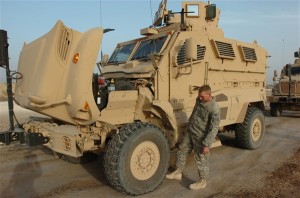 At the height of the Iraq War, the Department of Defense developed an emergency program of combat vehicles designed to protect troops from prevalent and highly destructive improvised explosive devices (IEDs). First fielded in 2007, the Mine-Resistant Ambushed-Protected (MRAP) vehicle would be credited with saving many lives in both Iraq and Afghanistan over the next five years.
At the height of the Iraq War, the Department of Defense developed an emergency program of combat vehicles designed to protect troops from prevalent and highly destructive improvised explosive devices (IEDs). First fielded in 2007, the Mine-Resistant Ambushed-Protected (MRAP) vehicle would be credited with saving many lives in both Iraq and Afghanistan over the next five years.
The MRAPs, however, were not without problems. To start, a combined fleet of 27,000 vehicles between the Army and Marine Corps cost the US around $45 billion dollars. This is a significant sum, especially considering the MRAP’s general unpopularity with soldiers. They regularly complained that the vehicle was too heavy, too unwieldy and broke down too often. Plans for the Joint Light Tactical Vehicle (JLTV) began almost immediately to eventually replace the MRAP as a lighter, more agile vehicle with the same protection capabilities.
Now, with the war in Iraq at a close and the war in Afghanistan drawing down, the future of the MRAP is uncertain. Strategically, the MRAP is ill-suited for the Asia pivot, particularly if the US does not intend to participate in any large-scale stability operations. The Marine Corps especially recognized the MRAP’s deployability limitations under the renewed concept of a sea-based, expeditionary force.
The Army, however, maintains that there will be an enduring requirement for the MRAP after US withdrawal from Afghanistan. According to a G-8 spokesman, approximately 60% of the 21,000 MRAPs currently held by the Army will be placed in storage or prepositioned stocks, 30% will remain in use with active units and 10% will be employed in home-based troop training. Additionally, a small number (roughly 300-400) will continue to be loaned to allies in the region and still others (an undetermined number) will be scrapped.
At what cost will the military store the majority of its MRAP fleet? Financially, the USMC alone has budgeted $144.4 million from 2014 to 2018 to sustain its 2,652 vehicles. The Army intends to upkeep roughly 12,500 during the same period. Using the Marine Corps’ math, the Army could spend roughly $680.6 million on the MRAPs during those four years, bringing the combined estimated total cost to $825 million for both service branches.
Deputy Secretary of Defense Ashton Carter commented this past spring that logistically, holding on to old systems hinders the military’s ability to acquire new systems with new capabilities. Furthermore, he stated that vehicle modernization in the last ten years has been “a lost decade for the Army”. Already some older MRAP models are in disuse or inappropriate for current tactical missions. That they could be sitting around for years and end up useless in future conflicts is a reality tacitly acknowledged by many Army officials.
Thom Shanker of the New York Times cites an example of this neglect from the Iraq War. “When the Third Infantry Division arrived in Kuwait as the vanguard for the invasion of Iraq in 2003,” he writes, “the tanks and fighting vehicles it drew from warehouses were inferior to those it had trained on in the United States. “
How the prepositioned stocks are maintained ultimately depends on funding from Congress and agreements with the host nations. As of late July, MRAPs are set to be stored in six locations around the world, encompassing Italy, the Western Pacific and the Persian Gulf.
Members of Congress, in fact, are the only ones who don’t seem overly concerned by this massive surplus. In the June report of the House Armed Services Committee, members note impending legislation that “would require the Department of Defense to provide strategic guidance for non-standard, enduring equipment such as MRAPs and a strategic training plan for operation and sustainment of unmanned systems.” Unfortunately, this requirement was buried in the National Defense Authorization Act for FY2013, passed by the House in May 2012 but certain to be rejected by the Senate or vetoed by the President.
As the fog of war clears, officials are faced with the consequences of rapid acquisition divorced from an overall strategy. Still, as unused MRAPs sit collecting dust, new technology, like the JLTV, continues to roll off the line without any long-term plans for its maintenance or eventual decommissioning. Continued unabated, this policy of “act now, think later” will devastate future military capabilities and severely compromise US national security.


